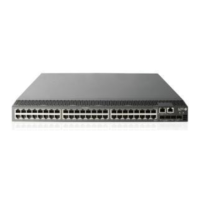98
Step Command Remarks
1. Use FTP or TFTP to transfer the
system software image to the
root directory of the master
switch's flash.
See "Configuring FTP" or
"Configuring TFTP."
The image file must be saved in the
root directory for a successful
upgrade.
2. Specify the file as the startup
software image for each
member switch.
boot-loader update file file-url slot
{ slot-number | all } { main |
backup }
In FIPS mode, the specified file
must pass authenticity verification
before it can be set as a startup
system software image.
3. Reboot the entire IRF fabric.
reboot N/A
Installing hotfixes
Hotfixes (called "patches" in this document) repair software defects without requiring a system reboot.
Basic concepts
Patch, patch file, and patch package file
Patches fix software defects.
A patch file contains one or more patches. After being loaded from the flash to the patch memory area,
each patch is assigned a unique number, which starts from 1. For example, if a patch file has three
patches, they are numbered 1, 2, and 3.
A patch package file contains patch files for multiple modules. It enables you to use one command to
bulk-fix bugs for multiple modules.
Incremental patch
Incremental patches are dependent on previous patches and cannot separately run. For example, if a
patch file has three patches, patch 3 can be running only after patch 1 and 2 take effect. You cannot run
patch 3 separately.
Patches that have been released are all incremental patches.
Common patch and temporary patch
Common patches are formally released to users.
Temporary patches are interim solutions that are provided to fix critical bugs. They are not formally
released.
A common patch always includes the functions of its previous temporary patches. The system deletes all
the temporary patches before loading the common patch.

